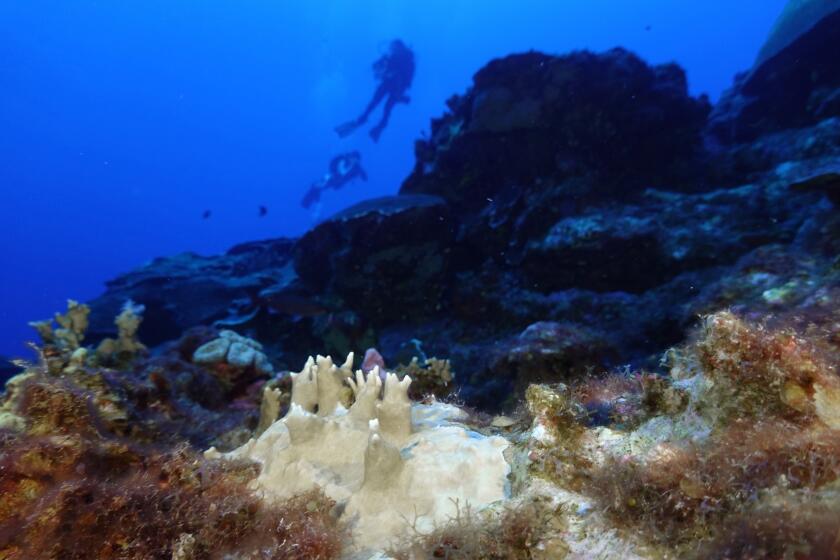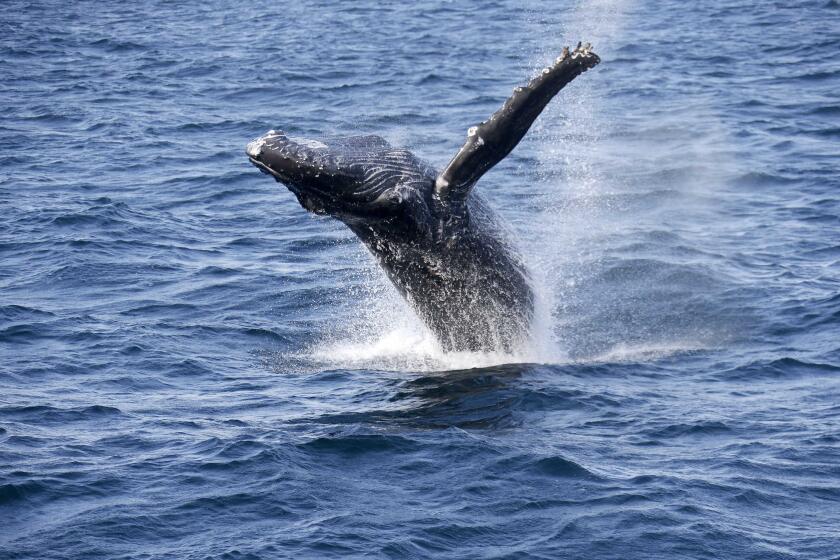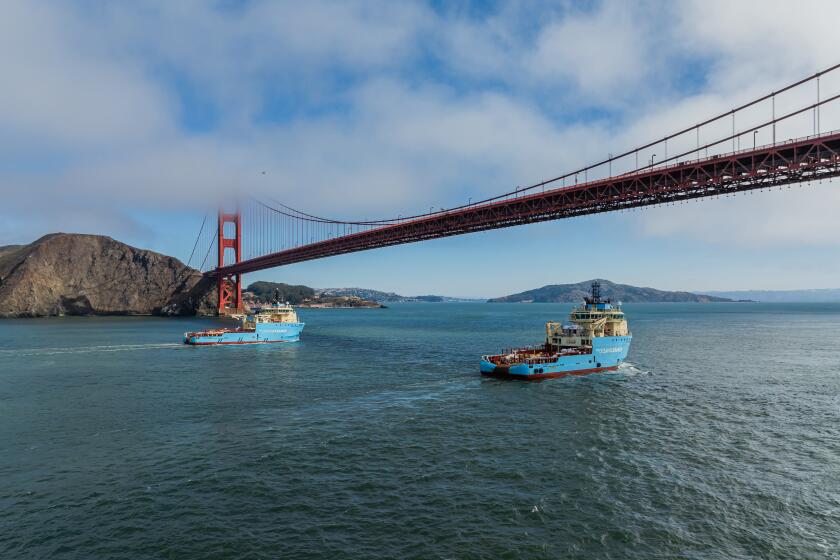
- Share via
On April 24, President Trump issued another questionable executive order, this one calling for deep-sea mining in both federal and international waters. The former is within his control; the latter would be a violation of international law.
Although the U.S. is not a signatory to the United Nations Convention on the Law of the Sea — the 1982 treaty ratified by 169 other nations that regulates maritime activities, including deep-sea mining, on and in the high seas — the U.S. has always abided by it. Until now.
“You know we’re sometimes an outlier on things like the Law of the Sea treaty,” says Rep. Jared Huffman (D-San Rafael), ranking member on the House Natural Resources Committee. “And what [Trump’s] doing with deep-sea mining is just making us even more of a lone ranger, if not a pariah.”
Coral is bleaching, kelp is disappearing, surface water temperature has hit hot-tub levels. The ocean’s ailments are approaching a boiling point.
Global mining consortiums have been eyeing mineral-rich nodules on the ocean floor since the 1970s. Sometimes as large as potatoes, the nodules form around a hard nucleus, such as a grain of sand or a shark’s tooth, accumulating minerals out of seawater and sediment over millions of years in the deep benthic zone, the least-studied of the ocean’s fragile ecosystems. Given the limits of 20th century technology, mining two to three miles below the ocean’s surface proved commercially impractical, to the relief of environmentalists and oceanographers.
But a bad idea that promises quick returns never gets old. Today, tech-driven mining corporations, such as the Metals Company of Canada, known as TMC, are leading the way back into the deep.
The UN’s International Seabed Authority, established under the Law of the Sea treaty, has granted TMC and other companies exploratory permits for deep-sea mining. Using massive mother ships, the companies deploy tank-tread “robotic excavators” (essentially, underwater bulldozers) or giant vacuum crawlers connected to pipes, pumps and miles of power cable. The Metals Company alone has recovered 4,500 tons of nodules. Now, TMC and the Trump administration are claiming that a novel interpretation of an obscure American law allows the U.S. National Oceanic and Atmospheric Administration to issue commercial mining permits in waters the rest of the world considers outside American jurisdiction.
The Saya de Malha Bank is one of the world’s largest seagrass fields and the planet’s most important carbon sinks. It faces incalculable risks that threaten the future of humanity.
In 1960, U.S. Navy Capt. Don Walsh was one of the first two humans to reach the deepest part of the ocean — the so-called Challenger Deep — along with Jacques Piccard, who piloted their bathysphere. Two years before Walsh died in 2023, he explained why opening large swaths of international waters to deep-sea mining would be a mistake.
“It’s kind of like clear-cutting the forest,” Walsh told me. “It doesn’t differentiate between the ore and the things that live on the seafloor. And these are organisms that take thousands of years to populate an area. So, I can’t support awarding mining permissions or licenses to areas that have not been carefully studied.”
That’s also the assessment of more than 900 marine scientists and policy experts from 70 nations who have signed a statement urging the United Nations to hold off on licensing mining operations “that could result in the loss of biodiversity and ecosystem functioning.”
The debris and pollution from the recent L.A. fires will eventually make their way to the ocean — and scientists will be gauging the impact.
What we don’t know about the deep ocean is astonishing. Just last year, a paper in the journal Nature showed that the nodule-covered seafloor in a 1.7-million-square-mile area between Hawaii and Mexico — where mining companies are already exploring — was producing “dark oxygen.” Until that revelation, scientists had considered sunlight, for photosynthesis, essential for ocean oxygen. The “huge” discovery, as described by the lead researcher, needs more study. Understanding the dark oxygen process could translate into the ability to sustain life on other planets or remake our understanding of how life began on Earth.
Mining the seabed raises other concerns besides the need to preserve dark oxygen. The oceans are a carbon sink. If the sediments are constantly stirred up, as they would be in mining, we “may be reintroducing that carbon back into the water column — and then ultimately back into the atmosphere,” NOAA Administrator Rick Spinrad cautioned me back when he ran the agency in 2023.
His remarks stand in sharp contrast to the headline on a recent fawning news release from the current NOAA — “‘The next gold rush’: President Trump unlocks access to critical deep seabed minerals” — and its subhead: “Historic executive order will boost economic growth, support national security.”
Industrial activity has added up to 15 decibels of noise to the Santa Barbara Channel, new research has found. Hear the difference.
The mining companies like to argue that scraping the bottom of the deep ocean is itself a climate solution and can be accomplished with appropriate ecosystem safeguards. The nodules are rich in manganese, copper, nickel and cobalt, key constituents of battery-powered clean energy, such as EVs.
“You’ve got to have a planetary perspective,” the Metal Company’s chief scientist Greg Stone insists, but critics question the environmental vision of the mining industry.
Thirty-three nations, including France and New Zealand, have called for a moratorium on deep-sea mining until the world’s largest habitat is better understood. Corporate customers including Google, Samsung, Philips, Volvo and BMW have pledged to keep deep-sea minerals out of their electric cars and other products.
The United States during the Biden administration supported a take-it-slow approach. Deep-sea mining “is not ready for prime time,” Monica Medina, assistant secretary of State for oceans and international environmental and scientific affairs, told me two years ago. For the present, Trump’s Secretary of State Marco Rubio is retaining that post but not that policy position.
The Ocean Cleanup, a Dutch nonprofit organization, has projected that the blight on the world’s largest ocean could be removed within a decade and for around $7.5 billion.
Like Trump’s America, China and India have shown keen interest in quickly bringing commercial mining operations to the planet’s last physical frontier. The tiny Pacific Island nation of Nauru, which has a contract with the Metals Company, has been pushing the Seabed Authority to finalize its deep-sea regulations and issue commercial permits.
Under Trump’s executive order, the United States is barreling ahead regardless, circumventing the Law of the Sea and the best advice of scientists who are pleading for a better understanding of what dredging the sea floor could destroy or unleash. On the high seas in the 21st century, the U.S. may prove to be the world’s newest pirate threat.
David Helvarg is the executive director of Blue Frontier, an ocean policy group. He co-hosts “Rising Tide: The Ocean Podcast.”
More to Read
Insights
L.A. Times Insights delivers AI-generated analysis on Voices content to offer all points of view. Insights does not appear on any news articles.
Viewpoint
Perspectives
The following AI-generated content is powered by Perplexity. The Los Angeles Times editorial staff does not create or edit the content.
Ideas expressed in the piece
- President Trump’s executive order on deep-sea mining bypasses international law, with critics arguing it violates the UN Convention on the Law of the Sea and undermines multilateral governance of ocean resources[1][5].
- Environmental scientists warn that deep-sea mining could irreversibly damage poorly understood ecosystems, including oxygen-producing seabed regions and slow-growing benthic organisms[1][5].
- Over 900 marine scientists globally have called for a moratorium on mining until ecological impacts are fully studied, citing risks to biodiversity and carbon cycling processes[1].
- Thirty-three nations and major corporations like BMW and Google oppose deep-sea mineral extraction, prioritizing preservation over short-term economic gains[1].
Different views on the topic
- The Trump administration frames seabed mining as critical for national security, citing the need to reduce reliance on foreign adversaries for battery minerals like cobalt and nickel[2][3][4].
- Federal agencies emphasize technological leadership, with NOAA accelerating exploration licenses and promoting public-private partnerships to map and process nodules[2][4].
- Proponents argue deep-sea minerals could accelerate clean energy transitions by supplying materials for electric vehicles and renewable infrastructure, claiming a “planetary perspective” justifies responsible extraction[1][4].
- The executive order leverages existing authorities like the Defense Production Act to subsidize domestic processing capabilities, though funding limitations raise questions about scalability[2][5].
A cure for the common opinion
Get thought-provoking perspectives with our weekly newsletter.
You may occasionally receive promotional content from the Los Angeles Times.














